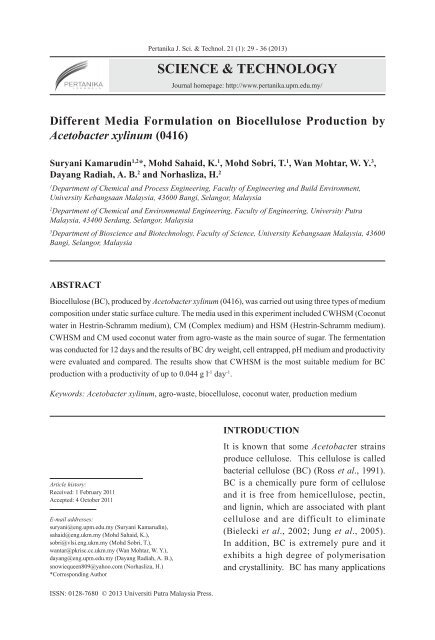JST Vol. 21 (1) Jan. 2013 - Pertanika Journal - Universiti Putra ...
JST Vol. 21 (1) Jan. 2013 - Pertanika Journal - Universiti Putra ...
JST Vol. 21 (1) Jan. 2013 - Pertanika Journal - Universiti Putra ...
You also want an ePaper? Increase the reach of your titles
YUMPU automatically turns print PDFs into web optimized ePapers that Google loves.
ISSN: 0128-7680 © <strong>2013</strong> <strong>Universiti</strong> <strong>Putra</strong> Malaysia Press.<br />
<strong>Pertanika</strong> J. Sci. & Technol. <strong>21</strong> (1): 29 - 36 (<strong>2013</strong>)<br />
SCIENCE & TECHNOLOGY<br />
<strong>Journal</strong> homepage: http://www.pertanika.upm.edu.my/<br />
Different Media Formulation on Biocellulose Production by<br />
Acetobacter xylinum (0416)<br />
Suryani Kamarudin 1,2 *, Mohd Sahaid, K. 1 , Mohd Sobri, T. 1 , Wan Mohtar, W. Y. 3 ,<br />
Dayang Radiah, A. B. 2 and Norhasliza, H. 2<br />
1 Department of Chemical and Process Engineering, Faculty of Engineering and Build Environment,<br />
University Kebangsaan Malaysia, 43600 Bangi, Selangor, Malaysia<br />
2 Department of Chemical and Environmental Engineering, Faculty of Engineering, University <strong>Putra</strong><br />
Malaysia, 43400 Serdang, Selangor, Malaysia<br />
3 Department of Bioscience and Biotechnology, Faculty of Science, University Kebangsaan Malaysia, 43600<br />
Bangi, Selangor, Malaysia<br />
ABSTRACT<br />
Biocellulose (BC), produced by Acetobacter xylinum (0416), was carried out using three types of medium<br />
composition under static surface culture. The media used in this experiment included CWHSM (Coconut<br />
water in Hestrin-Schramm medium), CM (Complex medium) and HSM (Hestrin-Schramm medium).<br />
CWHSM and CM used coconut water from agro-waste as the main source of sugar. The fermentation<br />
was conducted for 12 days and the results of BC dry weight, cell entrapped, pH medium and productivity<br />
were evaluated and compared. The results show that CWHSM is the most suitable medium for BC<br />
production with a productivity of up to 0.044 g l -1 day -1 .<br />
Keywords: Acetobacter xylinum, agro-waste, biocellulose, coconut water, production medium<br />
Article history:<br />
Received: 1 February 2011<br />
Accepted: 4 October 2011<br />
E-mail addresses:<br />
suryani@eng.upm.edu.my (Suryani Kamarudin),<br />
sahaid@eng.ukm.my (Mohd Sahaid, K.),<br />
sobri@vlsi.eng.ukm.my (Mohd Sobri, T.),<br />
wantar@pkrisc.cc.ukm.my (Wan Mohtar, W. Y.),<br />
dayang@eng.upm.edu.my (Dayang Radiah, A. B.),<br />
snowiequeen809@yahoo.com (Norhasliza, H.)<br />
*Corresponding Author<br />
INTRODUCTION<br />
It is known that some Acetobacter strains<br />
produce cellulose. This cellulose is called<br />
bacterial cellulose (BC) (Ross et al., 1991).<br />
BC is a chemically pure form of cellulose<br />
and it is free from hemicellulose, pectin,<br />
and lignin, which are associated with plant<br />
cellulose and are difficult to eliminate<br />
(Bielecki et al., 2002; Jung et al., 2005).<br />
In addition, BC is extremely pure and it<br />
exhibits a high degree of polymerisation<br />
and crystallinity. BC has many applications





